Merthyr Town
Formed 1908. Wound up 1934.
Founder Member of Division Three 1920. Failed re-election 1930.
Kit History
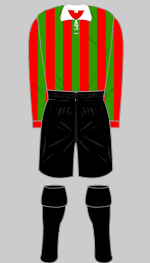
1908-1909 a c d
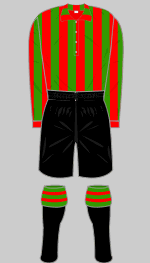
1909-1910 a c d
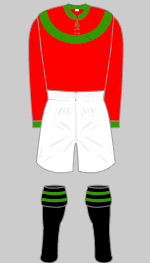
1911-1912 a d
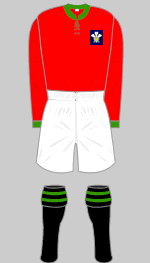
1912-1913 d

1913-1920 a c d
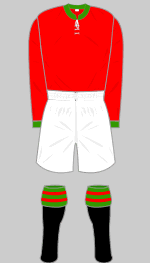
1920-1925 b d
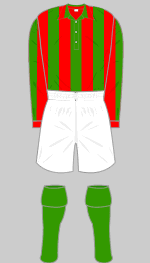
1925-1926 a c d
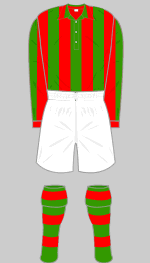
1928-1929 a d
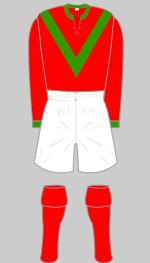
1933-1934 d
Background
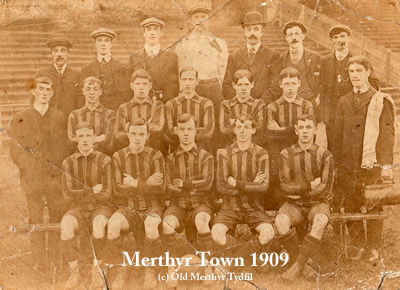
At the end of the nineteenth century, Merthyr Tydfil was an important and prosperous industrial centre at the head of the Rhondda Valleys, dominated by coal mines and steel works. Rugby Union was the most popular sporting pastime among the working class in the area but interest in the association code was sufficient for a number of amateur teams to be taking part in local and regional competition.
In 1907 a professional rugby club was formed and proved such an attraction that the existence of the established rugby union club was seriously threatened. (Professional rugby was outlawed by the strictly amateur Welsh Rugby Union and Merthyr must have played against fellow rebels from the Northern Rugby Union, which later became the Rugby League.) When the South Wales and Monmouthshire FA held its annual conference in Merthyr, a proposal from Merthyr RFC and Merthyr Athletics Association to form an association football club was well received and Merthyr Town AFC was conceived. Within three years both the rugby and northern union clubs had folded.
During the club's first match against Swansea United, the players wore black armbands in memory of Thomas Williams, who had broken his leg in a trial match earlier and subsequently died of complications.
The club became known as The Romans because their Pennydarren Park was on the site of a Roman fort but were more usually referred to as the Red & Greens. In 1909 they were accepted into Section A of the Southern League Second Division along with local rivals Ton Pentre and Aberdare. The Southern League was at this time a serious rival to the Football League and keen to expand into South Wales.
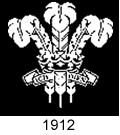 In 1912 clinched the Second Division championship and won the South Wales Cup. It was perhaps this success that prompted the addition of the Prince of Wales' feathers to the team shirts the following season.
In 1912 clinched the Second Division championship and won the South Wales Cup. It was perhaps this success that prompted the addition of the Prince of Wales' feathers to the team shirts the following season.
Promotion would mean fewer local derby games and increased travel overheads for the club who, during the long railway workers' and miners' strikes of the Spring of 1912, had reduced their admission prices to ensure their hard pressed supporters could continue to watch their games. To help with the additional travel, the Great Western Railway put a motor charabanc at the club's disposal so players could catch the early train from Newport for away fixtures. Despite the higher standard and increased number of games, the club finished a respectable 12th in the 20 team Southern League First Division but the following year they were relegated. At the end of the 1914-15 season, Merthyr Town closed down for the duration of hostilities.
In May 1919 Seymour Berry, a prominent local industrialist re-launched the club having wiped out their pre-war debts, allowing Merthyr Town to make a fresh start and a share issue raised £2,400. The club successfully applied for a place in the newly expanded Southern League First Division while a reserve team would compete in the Welsh League. The optimistic mood changed as Merthyr struggled all season, finishing next to last but they were saved from relegation by the decision to incorporate the Southern League First Division in to the Football League as the new Third Division.
The end of the war meant demand for coal and steel slumped and Merthyr, with aging, inefficient pits and foundries, suffered severe economic hardship. The miners' strike of April 1921 hit attendances hard: as unemployment rose gate receipts fell while costs rose and the club's financial situation became perilous. In 1925 Merthyr finished bottom of the League against a background of mass unemployment in the town and a board that had to dip into their own pockets to pay the summer wages bill for retained players. Despite this bleak prospect, Merthyr were re-elected. To mark what everyone hoped would be a fresh start, the club changed its colours from plain red shirts to stripes.
The General Strike of 1926, followed by a lengthy miners' strike, once again hit attendances and the club increasingly relied on the efforts of their Supporters' Club to make end meet. In 1928, the Red & Greens once again faced re-election and were in voluntary liquidation but they were saved when a local grocer and former director, Samuel Gibbon, took control and the club survived the re-election process, although with considerably fewer votes than three years previously. Attendances continued to fall over the following two seasons as the board tried to keep afloat by selling off any players that could command a transfer fee. In 1930 they finished a distant last and this time they were not re-elected at the League AGM in June.
A new syndicate was formed to run the club on a much reduced budget and they successfully applied for membership of the Southern and Welsh Leagues where it was hoped the lower standards would give the club a chance to survive as a professional team. Unemployment in the borough was, however, still rising and attendances fell even further. An attempt to boost crowds by reducing admission charges for the unemployment to 2d (less than 1p) was overruled by the Southern League. By 1934 even a wage bill of £30 a week was proving beyond the club's means while attendances were around the 100 mark. In June 1934 the directors announced that the club was to be wound up.
Since 1945 Pennydarren Park has been home to Merthyr Tydfil FC who, like their predecessors, play in the English non-league system.
This article draws heavily on Philip Sweet's valuable History of Merthyr Town AFC
Sources
- (a) Merthyr Tydfil FC (Images of Sport)
- (b) Rejected FC (Dave Twydell 1989) - information provided by Pete Wyatt.
- (c) Old Merthyr Tydfil
- (d) Merthyr Town AFC 1908-1934 - A History (Philip Sweet 2007)